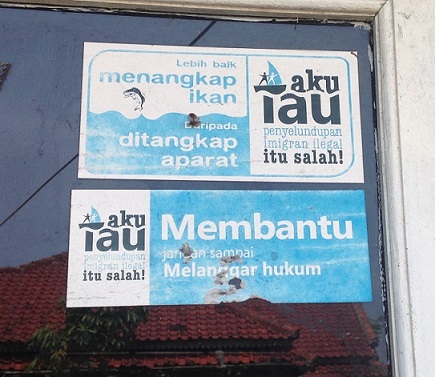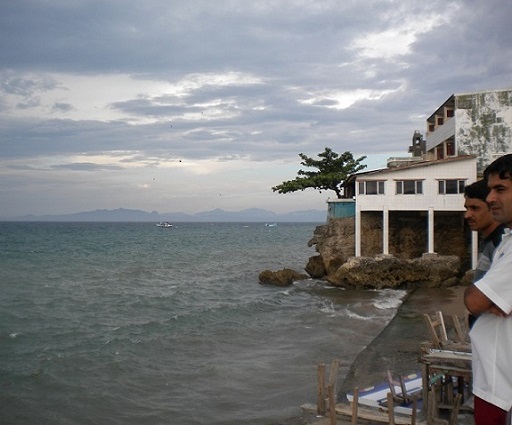Antje Missbach
Ismail, a young Hazara boy, is one of the few survivors from an overcrowded boat that sank on 17 December 2011 about 55 nautical miles from Java in bad weather typical of the rainy season. Of an estimated 250 passengers on board—mostly from Iran, Afghanistan and Iraq—more than 200 drowned or went missing. Indonesian fishermen rescued 34 people on the day of the sinking, before a heavy storm prevented further search and rescue efforts. By the time the Indonesian Search and Rescue Agency (Basarnas) were able to resume their search, two days after the incident, many victims had been swept miles away by the strong currents.
By Ismail’s account, around 150 people remained alive on the first day after the vessel sank. Their number dwindled to 80 survivors after the first night. By the second night just 35 people remained alive, of whom only 13 survived. Ismail watched many people drown, including one of his closest friends. From afar, he saw sharks circling the bodies. In the long hours of fear, hunger, thirst and sleep deprivation, he saw several boats pass by - not one of them came to their aid. Indonesian fishermen finally plucked Ismail from the water after he had been in the sea for two nights and almost three days.
The failures of the rescue operation for Ismail and his fellow passengers are not an isolated experience in Indonesia. On paper, Indonesia has acceded to international treaties governing search and rescue and safety of life at sea. In practice, it struggles to implement these treaties and meet its responsibilities.
Indonesia's exceptional geography is one obstacle to effective rescue operations at sea. As the world's largest archipelago, Indonesia has a maritime area under its control of approximately 3.1 million square kilometres, surrounding its more than 17,000 islands. It is hard to control such an enormous area effectively.
Indonesia's under-resourced marine safety institutions also lack the funding, staff and equipment to exercise efficient control. Basarnas in fact relies to a large extent on Australian authorities for information about asylum seeker movements and rescue situations.
Much as Australian assistance to Basarnas aids rescue operations, other Australian policies are exacerbating the risks that asylum seekers face. In particular, policies aimed at stopping rescued asylum seekers from being brought to Australia and preventing fishermen from smuggling asylum seekers are each creating new obstacles to their rescue at sea.
Indonesia's National Search and Rescue Agency
Basarnas carries out and coordinates rescue operations at sea with various other Indonesian agencies such as the navy, the maritime police, customs and immigration. According to Basarnas data, there were 47 operations involving the search and rescue of asylum seekers at sea in 2012, and 80 further such operations in 2013 to November. Since Australia launched Operation Sovereign Borders in September 2013, however, the number of asylum seeker boats leaving from Indonesia has decreased sharply. Fewer boat departures has meant fewer boats in distress, at least for the time being.
During rescue operations, Basarnas frequently cooperates with the Australian Maritime Safety Authority (AMSA) and the Australian Department of Immigration and Border Protection (DIBP). Basarnas also relies heavily on Australian intelligence sources, such as the Australian Federal Police (AFP) and also AMSA, for information about suspected irregular asylum seeker movements. Asylum seekers themselves are also more likely to provide information to AMSA than to Basarnas, as they prefer to be rescued by Australian teams. When onboard a vessel en route to Australia, asylum seekers usually have satellite phones and contact numbers for AMSA, but not for Basarnas. On occasion, asylum seekers have contacted AMSA to accelerate the ‘pick up’. Other rescued asylum seekers, who were taken back to Indonesia, have protested their return. Some have launched hunger strikes to avoid disembarking their vessel.
Coordination between Basarnas and Australian institutions is not always smooth. Critical hours have been lost in getting some rescue operations underway when Australian officials have not understood clearly who to contact or who held what responsibilities, or when no-one has answered their calls. The slow response time of Indonesian authorities has also often meant that victims have already drifted many miles away by the time they arrive on the scene. On occasion, Basarnas has also received incorrect coordinates.
Apart from government rescue agencies, commercial vessels in the vicinity of sinking asylum seeker boats are another possible avenue for rescue. However, rescued asylum seekers claim that commercial vessels have ignored their pleas for help when they were already in the water. Basarnas representatives have also on occasion highlighted the failure of passing commercial vessels to provide assistance, and speculated that vessels may intentionally ignore SOS calls.
Owners and captains of commercial vessels could have multiple different reasons not to provide assistance. They might worry about having insufficient security equipment and personnel on board to deal with rescued asylum seekers, particularly if they insist on being taken to Australia when rescuers would prefer to take them back to Indonesia. Anticipated financial losses resulting from delays caused by providing assistance may also be a strong disincentive. Last but not least, the complicated legal situation at sea and the highly politicised nature of carrying out rescue and providing assistance can act as an additional disincentive. The Australian government has threatened rescuers with severe punitive measures in the past, for instance in the case of Captain Arne Rinnan from the Norwegian freighter Tampa in 2001. The Australian government threatened to charge Rinnan with people smuggling if he were to bring the 438 asylum seekers he had rescued to Christmas Island instead of taking them back to Indonesia, a much longer journey for his freighter only designed to carry a small crew. Rescuers elsewhere in the world have also faced criminalisation. The crews of two Tunisian fisher boats who rescued 44 drowning asylum seekers in the Mediterranean Sea in August 2007 were subsequently charged with supporting illegal migration by Italian authorities. Each were eventually acquitted, but neither crew received compensation for the losses resulting from a lengthy trial.
Given the shortcomings of state maritime rescue organisations and the reluctance of commercial shipping lines, despite their obligation to rescue others at sea, many asylum seekers in fact owe their survival to rescue by ordinary Indonesian fishermen. The selfless help fishermen provide to drowning asylum seekers like Ismail faces a new obstacle though, in the form of Australian-funded public information campaigns. Seeking to prevent fishermen from becoming involved in the smuggling of asylum seekers, these campaigns may also dissuade them from rescuing asylum seekers.
Unintended side-effects
Since 2009, Australia has funded two public information campaigns in Indonesia as part of its regional counter-smuggling initiatives. Both are widely seen as a big success. The International Organization for Migration (IOM) implemented these campaigns in collaboration with the Indonesian police and the Indonesian Department of Immigration. According to IOM statistics, more than 30,000 people in fishing communities across Indonesia have received the message that “people smuggling is wrong”.. Other slogans included: “help – but not if it breaks the law”.
 Stickers distributed to fishermen communities urging them to not become involved in people smuggling Antje Missbach
Stickers distributed to fishermen communities urging them to not become involved in people smuggling Antje Missbach
One of the striking features of the public information campaigns is the way in which the counter-smuggling message is decontextualised from the broader issues surrounding asylum seekers. No mention is made of asylum seekers. The people in question are instead referred to as illegal immigrants. The reasons for why they come to Indonesia in the first place or why they wish to reach Australia usually also remain unstated.
The key message of the public information campaigns is that people-smuggling is a criminal offense. According to the 2011 Indonesian Law on Immigration, people-smuggling is not just the act of secretly transporting people without valid permits across a national border, but it also includes accommodating, hosting or hiding people without documents within Indonesia for the later purpose of crossing an international border. To convey this message to people with a low level of education, the campaigns package this message in emotive terms. Formerly imprisoned people-smugglers tell of the shame they feel for having committed such a crime and how their imprisonment has brought shame to their entire family. The campaigns also frame their message in religious terms: to smuggle people is to commit a sin.
As an unintended consequence of the public information campaigns, Indonesian fishermen at sea who come across sinking asylum seeker boats face an additional moral and economic dilemma. On the one hand, fishermen are aware that their own safety depends on the maritime culture of rescue at sea. They themselves could experience an emergency out at sea on any given day. On the other hand, having attended information sessions organised by these campaigns and knowing the legal consequences of involvement in people-smuggling, fishermen are afraid to be mistaken for smugglers when rescuing asylum seekers at sea.
During recent fieldwork in West Java, a popular point of departure to reach Christmas Island, fishermen spoke of their difficult choice of whether or not to help drowning asylum seekers. They know that Australian authorities intercept and destroy vessels found to be carrying ‘immigrants’ in or near Australian waters and that the boat crew could be perceived as smugglers. Recounting rescues of drowning asylum seekers, the fishermen said they always brought the asylum seekers back to Indonesia, no matter how close to Christmas Island they were. They returned to Indonesia even though the journey back required more fuel (a factor that should not be underestimated) and often took much longer, which can cause additional problems for rescued asylum seekers in need of immediate medical attention. The fishermen may even have exposed themselves to the risk of being beaten up by rescued asylum seekers, who vehemently disagree with being brought back to Indonesia.
Indonesian fishermen who rescue asylum seekers face long interrogations from the local authorities back home, which caused them further financial loss because of lost work days. For fishermen and their families living day to day on very low incomes these kinds of losses represent a genuine disincentive to rescue. Any future campaigns seeking to prevent the involvement of Indonesian fishermen in people-smuggling must address these negative side-effects.
Indonesia’s new maritime aspirations
It has been more than a year since an asylum seeker drowned in the sea between Indonesia and Australia. The main reason has been that very few asylum seeker boats have departed Indonesia. Yet Australia has relied on very questionable measures to immobilise asylum seekers in Indonesia, including forced returns and tow-backs of asylum seeker boats. Australia’s navy also breached Indonesia’s territorial waters during Operation Sovereign Borders, causing great indignation in Indonesia. Both governments see asylum seeker issues as one of the thorns in the bilateral relationship.
As such, it is hardly surprising that Indonesia’s new president Joko Widodo faces enormous expectations to restore Indonesia as a maritime power and redefine the Indonesia-Australia relationship. Jokowi promised to strengthen Indonesia’s maritime security in his election manifesto, and pledged to transform Indonesia into a strong maritime nation in his inauguration speech. He has created a new ministerial post, the Coordinating Maritime Affairs Ministry. Unfortunately, so far, Jokowi’s new vision for Indonesia’s maritime strength does not include any special consideration of protecting asylum seekers, whether on land or at sea. Many more lives could be saved at sea in the future, if more funding and resources were directed to maritime rescue institutions and their operations rather than to restrictive border protection measures, which often lead to disincentives for the rescue of drowning asylum seekers at sea.
Antje Missbach (antje.missbach@monash.edu) is a research fellow at Monash University, Melbourne.
Inside Indonesia 119: Jan-Mar 2015{jcomments on}
